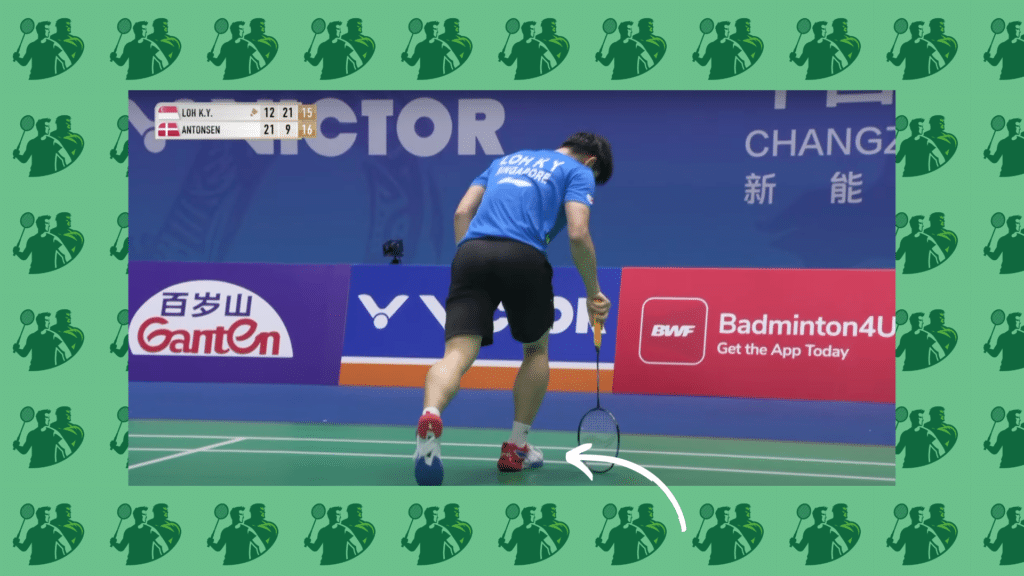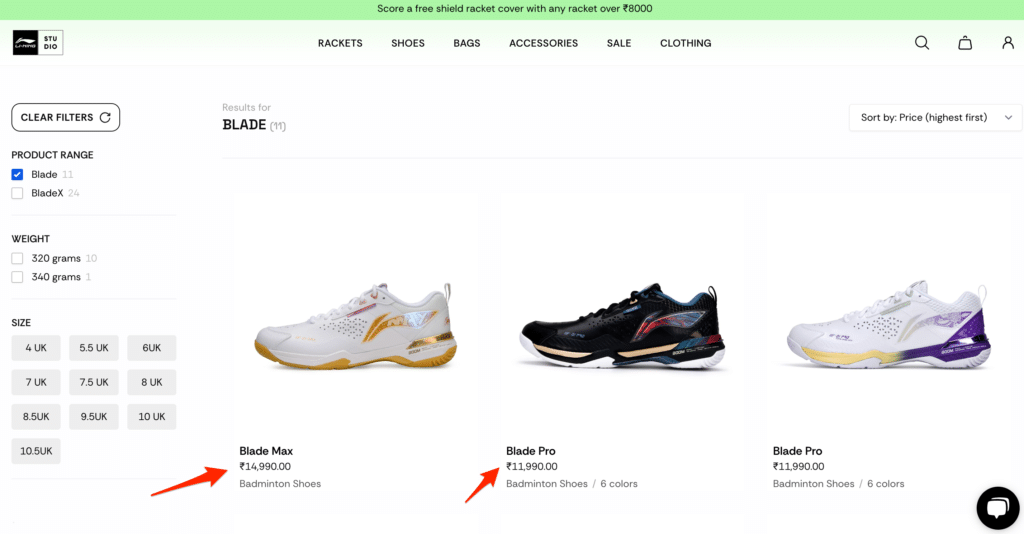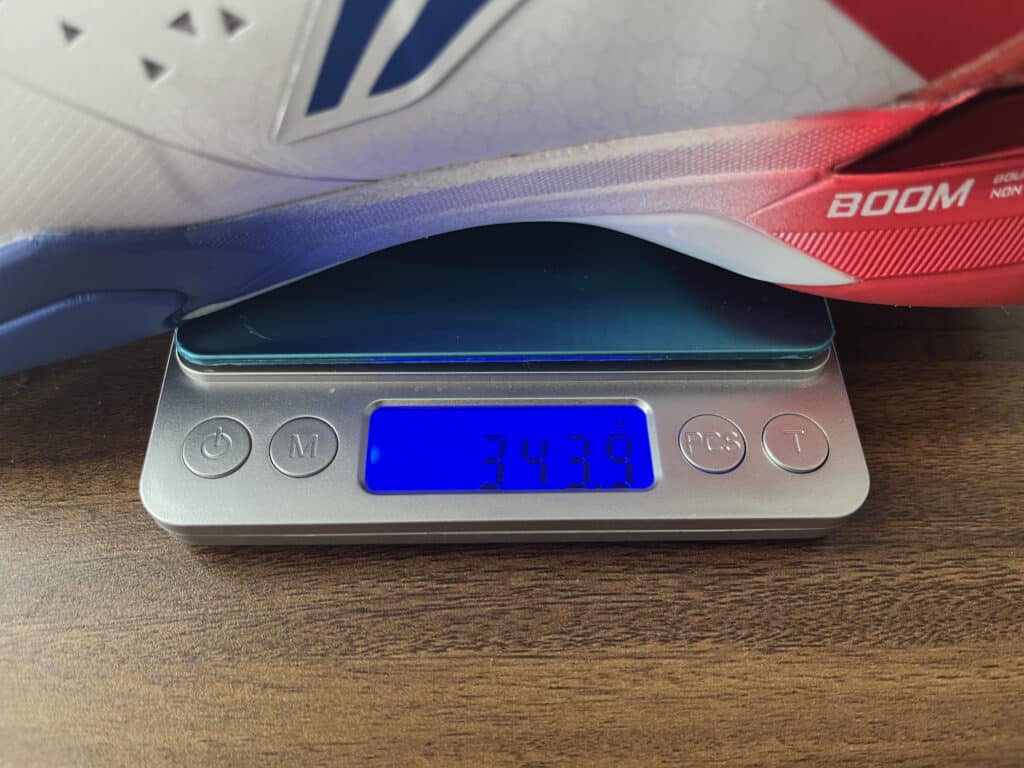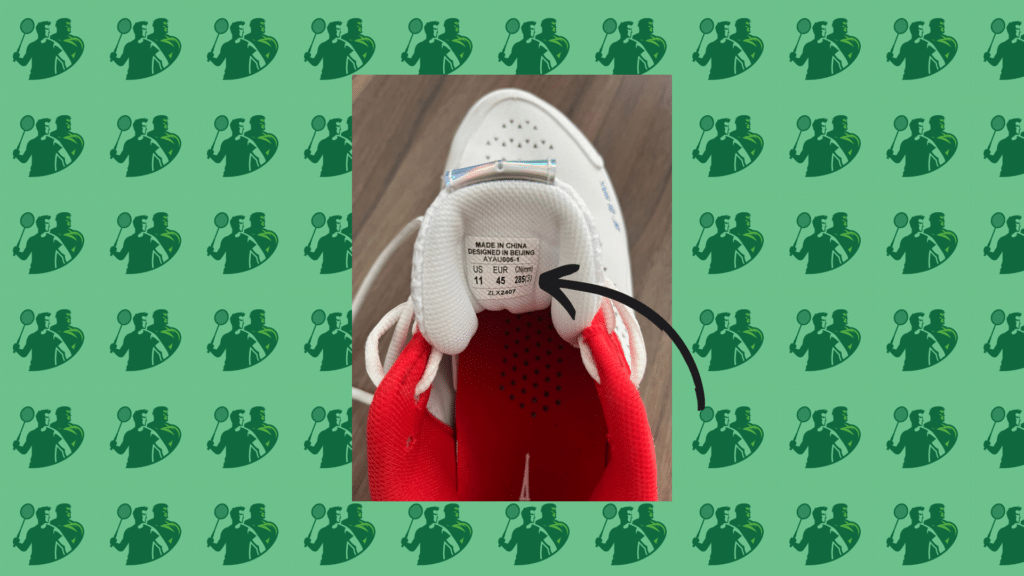
I’m using the Paris Olympic 2024 edition for this Li-Ning Blade Max review (Loh Kean Yew’s current shoe), but it’s no different from the standard Max edition besides the look.

Before testing it, I had ordered the sibling, the Blade Pro, but it turned out to be in the wrong size and I had to return it without having it on court as it wasn’t available in my size at all.
Before I did, I had a quick look as it’s Yuta Watanabe’s current shoe, and appeared to be the main shoe in the all around badminton shoe category from Li-Ning.
It felt very similar to the Li-Ning Blade Max I’ll be reviewing today, but with a touch less cushion. I’m guessing that the ‘Max’ in ‘Blade Max’ is referring to cushion as I’ve noticed other shoe brands do with running shoes.

That shows in the price. A quick glance online suggested that there’s a 10-25% percent difference between the two models, with the Blade Max being the more expensive of the two.

In terms of weight, it falls somewhere in the middle for badminton shoes in the all around category at 343.9g per shoe in my size 28.5.

As usual, I’ve had this shoe on court for 10 hours to see how it plays.
If you prefer to watch this in video format as opposed to reading, I’ve added the video below which covers about the same as this written review.
Table of Contents
Li-Ning Blade Max review and my experience
Now, let’s dive into the Li-Ning Blade Max review and see how it plays!
The toe area and protection
First, let’s look at the toe box.
For a supposedly cushioned shoe, it doesn’t have much cushioning in the toe box as my mediocre footwork and late lunges exposed.
It isn’t as bad as you’d think though, as Li-Ning adds 3 MM to their sizing which I’m guessing is instead of adding thick toe box cushion.
It didn’t cause much of an issue with fit for me, but had the benefit of lowering the weight of the shoe while adding a buffer when my toes were being pushed forward within the shoe that served as the cushion.

Naturally, it wasn’t as comfortable as a thick cushion, but it’s a good option in an all around shoe since the toe box cushion often isn’t much in order to keep the weight low.
In all around shoes, this works, but I’ve found that it isn’t as effective in badminton shoes in the supportive category where I’d expect a more comfy and cushioned feel.
In terms of fit, the toe box wasn’t as wide as I’ve experienced with the top Yonex shoes, but it wasn’t super narrow either. It felt like the perfect middle ground, which is a shame as I came to like the narrower fit in the Mirage Pro and Saga II SE (specifically in the toe box).
The heel area
The upper heel has a big and thick sausage cushion covering both sides of the ankle and heel. It felt soft and comfy with a touch of stiffness underneath the cushion at the upper area — as if the upper half of the heel is cushion and the bottom has a stiff inserted plate to keep the shape.
This helps if you worry about rolling your ankle with cushions that are too thick and soft as it appeared at first glance to me.
The fit here felt comfy rather than tight and snug, which is to be expected from a thick cushion even if it wasn’t my favorite — I prefer something tighter with less cushion. I used to prefer that extra cushion, but since having tried shoes that are narrower, stiffer and more snug, I’ve come to like that more.
Fit + Upper shoe area
I’d describe the tongue as medium cushioned, but it had a fairly snug fit when combined with the upper area of the heel and ankle.
Some shoes have annoyed me with the tongue sliding down the side regularly and needing adjustment between rallies, needing me to retie to the shoe.
I expected that to be an issue here due to the cushion, but it fortunately wasn’t.
In terms of fit, the sides, upper area and middle of the shoe felt quite snug without it being as much as the Li-Ning Mirage Pro. Slightly on the narrower side of the middle of the scale.
Breathability and heat was no issue for me in this model. Even though I play in hot conditions, I didn’t think about it once.
Next, let’s move on to the cushion in the midsole underneath your feet.
Cushion and shock absorption (midsole)
I have to admit that I totally forgot about the midsole at first as it gave me no issues in terms of fatigue underneath my feet.
This will usually be one of the areas I notice if there isn’t enough and the fatigue I get underneath my feet can cause extra fatigue in my legs and knees as well.
This wasn’t an issue for me. While it wasn’t the softest and most spongy or bouncy shoe in the midsole, preventing fatigue is critical for me and it suited my body size well with what it offered.
Suitable for a shoe balancing weight and cushion.

I liked the insole with its wavy pattern, and I’m noticing that Li-Ning seems to be adding that one to all their new top-tier models, as I found in the Mirage Pro and the Li-Ning Saga II SE.
That is great news for many of us as the insole is fairly soft, thick, and the wavy pattern in the toe area helps prevent sliding within the shoe (which I had no issues with in this model).
The outsole and grip
The outsole grip is on par with the best I’ve come across out there. That for me is in line with other top shoes from Li-Ning along with Yonex’s radial blade sole grip.
The outsole has a thick crossing ‘block’ at the middle of the outsole, separating the front and back area of the shoe.

Li-Ning calls this their Probar Loc and puts it in most of their flagship badminton shoes. This seems to help with stability.
Durability
It’s hard to learn much about durability from playing with a shoe for ten hours on court, so this section is more meant to catch anything truly concerning relative to other badminton shoes rather than give you a long term view.
I’ve had some shoes tear open after just a few sessions on court, but this pair was in line with what I’ve experienced with most other top-of-the-line badminton shoes, so no issues there.
The overall verdict + summary box
POSITIVE
The midsole underneath the shoe gave me no fatigue either in my feet or legs after playing.
NEGATIVE
The heel and ankle area is too cushioned for my preference.
Li-Ning Blade Max: the verdict

Summary + the beasty score
This Li-Ning Blade Max review feels overly positive as I’m writing it, but it’s hard to say something particularly negative about this badminton shoe.
It balances a reasonably low weight with a fair amount of cushioning and comfort for what I’d expect in this category.
The midsole especially, is critical for whether I’ll return to this shoe between tests as the shoe to beat in the category.
The Blade Max isn’t hard to recommend for players around my body size who prefer a blend with plenty of cushion and medium weight, while still having a touch of stiffness.
I’d like it to be that bit stiffer and less comfy, except in the midsole, but that comes down to my preference.
The fit feels like something that falls perfectly in the middle of the scale, and not snug enough for me.
If a medium fit (in terms of width) and comfy cushion sounds good to you, the Li-Ning Blade Max will likely be a good fit for you.
This is likely the most comfortable all around shoe I’ve tested — more than Victor’s A970Ace — while still being nicely stiff (even around the heel which is very cushioned).
Let’s summarize who this shoe is for and compare it to other similar models next.
Which badminton players are best suited for Li-Ning Blade Max
First, let’s get a sense of which type of player this shoe is for.
Who Li-Ning Blade Max is suited for
- Players with medium body frame who prefers a balance between comfort and relatively low weight
- Players who like an average sized fit (in terms of width)
Who Li-Ning Blade Max is not suited for
- This shoe isn’t suited for the player with wide feet. It also isn’t great for super narrow feet, but it’s possible to make it work
Li-Ning Blade Max compared to other similar shoes
As the last step in this Li-Ning Blade Max review, let’s compare it with other similar shoes head-to-head.
Li-Ning Blade Max vs Li-Ning Yun Ting
Li-Ning’s Blade Max and Yun Ting are possibly the two most similar pairs of badminton shoes I’ve come across, which still seem to be in different series.
Most of all, it feels as if the Blade Max is a slightly softer, more cushioned and upgraded edition of the Yun Ting with better outsole grip.
On the other hand, the Yun Ting feels a touch stiffer but still with a soft and thick cushion in the heel, even if it’s that tiny bit less. Again, we are talking about the minutiae here.
In terms of fit, it felt slightly narrower from heel to toe, including the toe box,, which may be due to less cushioning. Speaking of cushioning, both had the same minimal toe box cushioning but were helped by the extra 3 MM in the sizing I mentioned earlier.
Li-Ning Blade Max vs Yonex 65z3
I also wanted to compare the Blade Max to the popular Yonex SHB 65z3 many players are familiar with.
The Li-Ning Blade Max feels more cushioned in the sides and around the upper heel area (including the tongue). At the bottom half the heel and sides (but still above the midsole) it felt more stiff.
The Blade Max feels like it has some added stiffness to compensate for the comfy cushion it also has, whereas the 65z3 just feels stiff and hard. Except in the heel where it has a bit of cushion, but not much compared to the Blade Max and more similar to other all around shoes.
The SHB 65z3 feels more snug in the sides and the upper area near the tongue, while being more roomy in the toe box (this can help prevent your foot from moving around too much within the shoe, but it doesn’t prevent my narrow feet from banging my toes against the sides of the shoe and cause fatigue, though).
I like the snugger fit — the sides feel really close to the foot compared to the cushioned upper sides of the Blade Max — but the roomy toe box isn’t good for me. The Blade Max doesn’t have a narrow toe box, it’s just narrower than this Yonex 65z3.
In terms of toe box cushion, these two models feel about the same to me. There isn’t much cushion in either, but the Blade Max has those 3MM extra as a buffer and that works better for me to avoid fatigue with my less-than-stellar footwork.
In terms of midsole and fatigue underneath your feet, I found the Yonex 65z3 far less comfortable and more fatiguing than the Li-Ning Blade Max. I noticed quite a difference when I changed shoes between games to compare directly.
Outside and grip-wise, these two felt about the same and are both best in class.